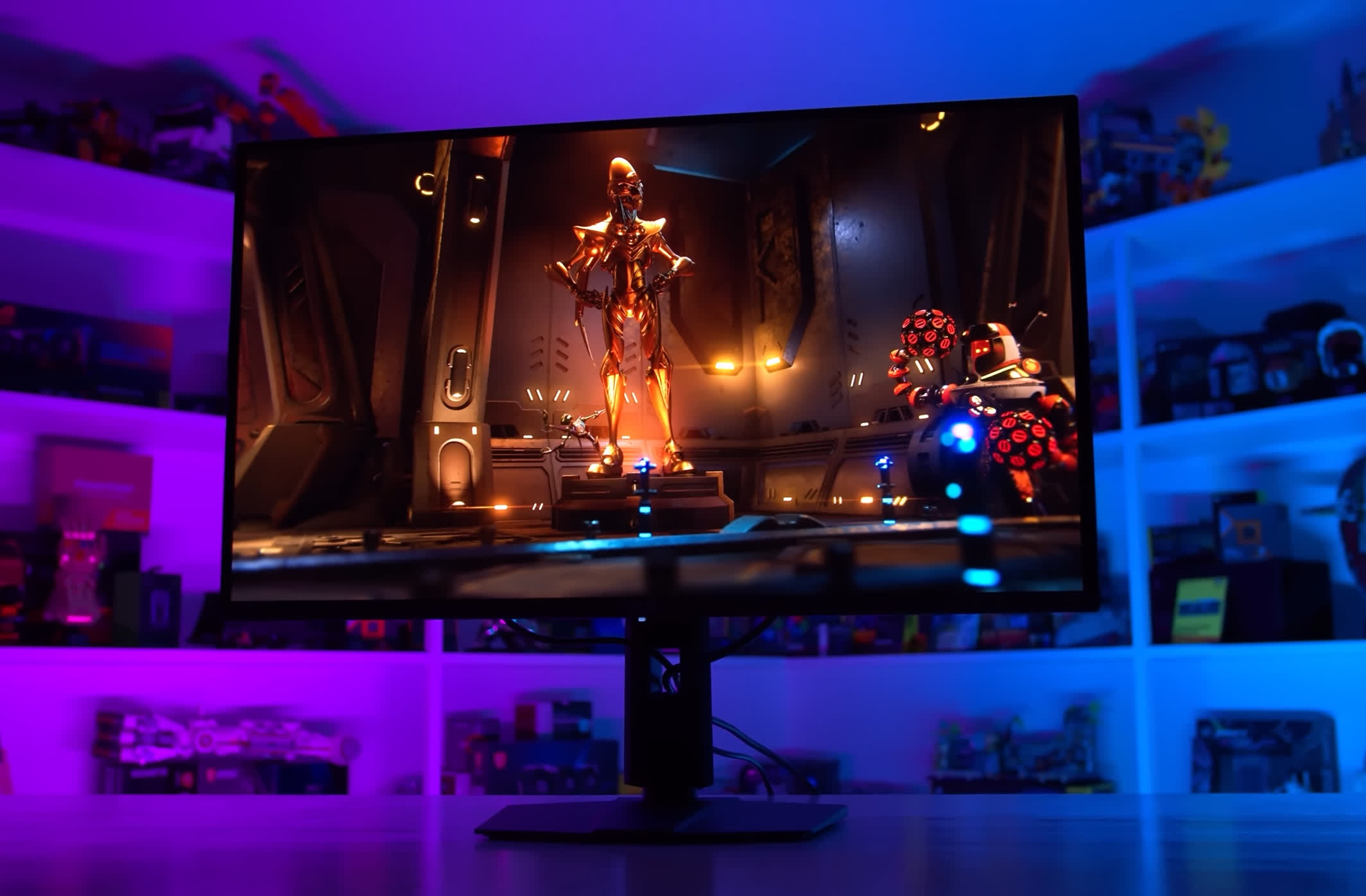Nine months into our 4K OLED monitor stress test, we're putting the MSI QD-OLED through extreme productivity tasks with 8+ hours daily of static content to test its durability. Here's our update.
You are using an out of date browser. It may not display this or other websites correctly.
You should upgrade or use an alternative browser.
You should upgrade or use an alternative browser.
The OLED Burn-In Test: 9-Month Update
- Thread starter Scorpus
- Start date
passwordistaco
Posts: 611 +1,320
seeprime
Posts: 873 +1,269
Great testing technique. I appreciate your work. My LG C1 is on about 16 hours a day and stull looks great after over 7000 hours of use at 95% brightness setting. OLED displays are excellent these days. Until micro LED becomes affordable, OLED screens are the best option for optimal color gamut and pure blacks.
AnilD
Posts: 153 +209
RTINGS.com
(It only took 700 hours before screen damage to occur...)
Thing is, that is an OLED TV, not QD-OLED. Similar technology but not the same generation of hardware.
For the purpose of this article (and future articles on the series), this is testing a newer 2nd-gen QD-OLED monitors to see how it withstands burn-in. Not the same as buying any OLED TV and using it as a PC monitor.
airbornex
Posts: 96 +74
You're basically running an unholy OLED endurance test so the rest of us can comfortably toggle our dark modes. You're doing OLED God's work, my friend.
gamerk2
Posts: 1,151 +1,212
I will say the OLED is holding up better then my old LG B6P, where the taskbar burnt in after just over a year. But yes, you nailed the major points to OLED longevity:
Minimize the taskbar
Dark Mode
Lower OLED Brightness (I'm running @30 on my LG C2)
Set to Sleep after 5 minutes
If you're getting an OLED, you aren't getting it for primarily productivity, but it is important to consider for those of us who will use it for at least a little for that role.
Minimize the taskbar
Dark Mode
Lower OLED Brightness (I'm running @30 on my LG C2)
Set to Sleep after 5 minutes
If you're getting an OLED, you aren't getting it for primarily productivity, but it is important to consider for those of us who will use it for at least a little for that role.
yRaz
Posts: 7,115 +11,052
Get 2 years out of something that costs 1/4th my rent. Idk, I'm okay with OLEDs being disposable for ~$500And people keep sayin how you can use OLED like this and get away with it... for years... Right... This shows that you cant. Most tests show this too. I aint buying a monitor that wont last more than 8 years. Yes more than 8. Especially if the cost of it is sooo high.
It really depends on your use case. If it’s a TV and you are using it for media/ gaming use, I believe it’s less likely to cause burn in since there’s less static images. I do think that chances of burn in makes OLED monitor less attractive for me, especially when they cost so much over conventional IPS displays. For now, I feel mini LED is as far as I will go.Great testing technique. I appreciate your work. My LG C1 is on about 16 hours a day and stull looks great after over 7000 hours of use at 95% brightness setting. OLED displays are excellent these days. Until micro LED becomes affordable, OLED screens are the best option for optimal color gamut and pure blacks.
Of course you can. He is trying to burn it in on purpose, and on top of that he is using a burn in test to detect the burn ins. If you do that test on a non oled monitor, it comes "burned in" straight out of the box.And people keep sayin how you can use OLED like this and get away with it... for years... Right... This shows that you cant. Most tests show this too. I aint buying a monitor that wont last more than 8 years. Yes more than 8. Especially if the cost of it is sooo high.
Guess people don't understand that non oled monitors look worse straight out of the box than oled monitors do after 9 months of torturing them.... Oh well
seeprime
Posts: 873 +1,269
It's used for streaming services and during the day over the air showd, like various news outlets. It's visual wallpaper at other times. It's been solid.It really depends on your use case. If it’s a TV and you are using it for media/ gaming use, I believe it’s less likely to cause burn in since there’s less static images. I do think that chances of burn in makes OLED monitor less attractive for me, especially when they cost so much over conventional IPS displays. For now, I feel mini LED is as far as I will go.
godrilla
Posts: 1,616 +1,067
Running my cx 48 inches for 4.5 years at maximum brightness and no burn in yet.I will say the OLED is holding up better then my old LG B6P, where the taskbar burnt in after just over a year. But yes, you nailed the major points to OLED longevity:
Minimize the taskbar
Dark Mode
Lower OLED Brightness (I'm running @30 on my LG C2)
Set to Sleep after 5 minutes
If you're getting an OLED, you aren't getting it for primarily productivity, but it is important to consider for those of us who will use it for at least a little for that role.
Attachments
gamerk2
Posts: 1,151 +1,212
I'm *very* hesitant at running at full brightness after my personal experiences with my B6. Very early OLED sure, but you are essentially sacrificing overall lifetime for more brightness. I've found that I adjusted to a lower brightness (30) *very* quickly, but obviously this depends on the person/environment.Running my cx 48 inches for 4.5 years at maximum brightness and no burn in yet.
godrilla
Posts: 1,616 +1,067
I personally would not use an oled display for professional use and only for content consumption. If using it and wanting to maximize lifespan of the display at a minimum use all mitigation techniques available by the panel vendor and windows settings. Being cognizant of bright static windows like as Core temps app and windows' apps with bright images that are static that can potentially burn in; by either hovering a darker window over the desktop or shifting the white bright window around should help as well. When using the PC other than playing games/content consumption I use blue light filter ( which lowers brightness ) and turn HDR off ( which further lowers brightness ).I'm *very* hesitant at running at full brightness after my personal experiences with my B6. Very early OLED sure, but you are essentially sacrificing overall lifetime for more brightness. I've found that I adjusted to a lower brightness (30) *very* quickly, but obviously this depends on the person/environment.
Lastly I believe that the ambient and surface temperature can facilitate or preserve the oled pixels. The warmer the climate and ambient temperature the faster the pixels degrade. When you shut off the display or shift a dark window it gives the pixels time to cool down.
This last part of temperature affecting the oled pixel lifespan is my working theory. I live in NY city where the climate ranges (from very cold to hot ) but is mostly cool and does get warm for 1 quarter. My average ambient room temperature is around 70 degrees *F and can reach low 80s only a few months in the summer during long game sessions.
In conclusion, if the ambient/surface temperature does affect the lifespan of the oled pixels as a culprit then consumers should as minimum use controlled room temperature via air conditioning ( maybe don't have your pc close to the display as well.) If consumers use these mitigation techniques for content consumption even with the maximum brightness they should be able to enjoy the display without the fear of burn in for at least 5 year use ( almost my use case .)
If anything changes to the panel I will let you guys know as well.
Blur Busters / TestUFO here:
Anecdotally, and from ongoing dogfooding-OLED-in-office tests, my experience is that modern WOLED (240Hz+) seems to have better longevity than QD-OLED. For office use cases, I've been using WOLED for 2 years with no burn-in so far.
RTINGs also observed some LCDs degrade, so it would be cool to see the future test expand to see how fast LCDs degrade relative to the best OLEDs. It's all relative -- LCDs do often go splotchy grey fields. I have seen several 5-year-old VA Panel gains 10x more grey-field splotchiness than the look of OLED burn-in; so YMMV.
The early OLEDs definitely burned in fast, but the latest WOLED's (240Hz+ minimum) should be able to last 5 years with less burn-in than this 9-month test, from my internal office tests.
Someone should also try out QD-OLED vs WOLED, and I also hear LG is coming out with RGB (no W subpixel) OLED's too later this year, so that shall be interesting. The new 2000-3000nit brightness headroom should allow for easy 200nit office usage with much better longevity.
It may be a good idea to mention:
- The WOLED vs QD-OLED angle
- The LCD degradation angle
This is my projected generalities: Currently WOLED is now ready for office use, 5-year is now possible with less burn in than these 9-month torture-test images. Mandatory variables: Must be a recent OLED chemicals and formulations. In this case, it's a 240Hz+ WOLED.
I prefer the colors of QD-OLED, but there is no problem purchasing a 4K 240Hz WOLED for Visual Studio productivity. I've got a 2-year DVT prototype Corsair Xeneon Flex prototype here, being abused, and no-burnin after 2 years.
There is a quirky temporary-retention phosphorescent behavior that fades after 10 minutes on a solid screen, then no permanent burnin remains (Testing Suite: Let an OLED rest at a blank screen for 10 minutes before photographing for permanent burn-in efffects). Otherwise you accidentally photograph temporary image retention (phosphorescent effects) instead of the permanent burnin effects (persistent all-day afterimages).
More information about QD-OLED vs WOLED would be lovely, as I'm not focussed on creating a QD vs WOLED burn in test, as that's stuff I let people like TechSpot and RTINGs do. However, it's quite important to nuance.
RGB-OLED's burnt in the fastest (e.g. early OLED smartphones), while QD-OLED and WOLED burns in slower, and recent formulations burns in even slower, especially tandem OLED because you now only need to drive each layer at lower nits.
Also wear is geometric -- 120-nit has been obsered to last more than 3x-4x longer than 240-nit. Possibly much more geometric than that, but it varies depending on the panel and how hard the pixels are driven. Well-underdriven LED's last an awfully long time. Even 4x brightness accelerates burnin by MORE than 10x.
There are *some* OLED formulations in already-shipping monitors that are predicted to have less burnin after 5-years than this TechSpot 9-month test. The problem is nobody yet has 5-year numbers for a 240Hz OLED.
Current Blur Busters Best Practices for OLED in Offce
- Currently, recent 240Hz+ WOLED is a safer bet for office use until further QD-OLED tests;
- Observe lack/few burn-in complaints for this type (240Hz+ fabrication of WOLED);
- QD-OLED nicer colors; needs more field testing for heavy office use scenarios;
- Turn off ClearType unless using the new RGB pixel structure coming out;
- Stick to recent WOLEDs with 3-year burnin warranty;
- Dark Mode recommended;
- Taskbar Autohide (though I disabled it during dogfooding).
My general guideline is that OLED is now ready for office use, but you must cherrypick, mitigate risks, plus consider the geometric wear effect of merely doubling brightness, amongst other variables. YMMV.
Anecdotally, and from ongoing dogfooding-OLED-in-office tests, my experience is that modern WOLED (240Hz+) seems to have better longevity than QD-OLED. For office use cases, I've been using WOLED for 2 years with no burn-in so far.
RTINGs also observed some LCDs degrade, so it would be cool to see the future test expand to see how fast LCDs degrade relative to the best OLEDs. It's all relative -- LCDs do often go splotchy grey fields. I have seen several 5-year-old VA Panel gains 10x more grey-field splotchiness than the look of OLED burn-in; so YMMV.
The early OLEDs definitely burned in fast, but the latest WOLED's (240Hz+ minimum) should be able to last 5 years with less burn-in than this 9-month test, from my internal office tests.
Someone should also try out QD-OLED vs WOLED, and I also hear LG is coming out with RGB (no W subpixel) OLED's too later this year, so that shall be interesting. The new 2000-3000nit brightness headroom should allow for easy 200nit office usage with much better longevity.
It may be a good idea to mention:
- The WOLED vs QD-OLED angle
- The LCD degradation angle
This is my projected generalities: Currently WOLED is now ready for office use, 5-year is now possible with less burn in than these 9-month torture-test images. Mandatory variables: Must be a recent OLED chemicals and formulations. In this case, it's a 240Hz+ WOLED.
I prefer the colors of QD-OLED, but there is no problem purchasing a 4K 240Hz WOLED for Visual Studio productivity. I've got a 2-year DVT prototype Corsair Xeneon Flex prototype here, being abused, and no-burnin after 2 years.
There is a quirky temporary-retention phosphorescent behavior that fades after 10 minutes on a solid screen, then no permanent burnin remains (Testing Suite: Let an OLED rest at a blank screen for 10 minutes before photographing for permanent burn-in efffects). Otherwise you accidentally photograph temporary image retention (phosphorescent effects) instead of the permanent burnin effects (persistent all-day afterimages).
More information about QD-OLED vs WOLED would be lovely, as I'm not focussed on creating a QD vs WOLED burn in test, as that's stuff I let people like TechSpot and RTINGs do. However, it's quite important to nuance.
RGB-OLED's burnt in the fastest (e.g. early OLED smartphones), while QD-OLED and WOLED burns in slower, and recent formulations burns in even slower, especially tandem OLED because you now only need to drive each layer at lower nits.
Also wear is geometric -- 120-nit has been obsered to last more than 3x-4x longer than 240-nit. Possibly much more geometric than that, but it varies depending on the panel and how hard the pixels are driven. Well-underdriven LED's last an awfully long time. Even 4x brightness accelerates burnin by MORE than 10x.
There are *some* OLED formulations in already-shipping monitors that are predicted to have less burnin after 5-years than this TechSpot 9-month test. The problem is nobody yet has 5-year numbers for a 240Hz OLED.
Current Blur Busters Best Practices for OLED in Offce
- Currently, recent 240Hz+ WOLED is a safer bet for office use until further QD-OLED tests;
- Observe lack/few burn-in complaints for this type (240Hz+ fabrication of WOLED);
- QD-OLED nicer colors; needs more field testing for heavy office use scenarios;
- Turn off ClearType unless using the new RGB pixel structure coming out;
- Stick to recent WOLEDs with 3-year burnin warranty;
- Dark Mode recommended;
- Taskbar Autohide (though I disabled it during dogfooding).
Code:
// Office OLED formula
if ((panelTech == "WOLED") &&
(refreshRate >= 240) &&
(darkMode == true) &&
(autoHide == true) &&
(brightnessDuringOfficeUse == average))
{
shouldBeFineAtYearFive = true;
}My general guideline is that OLED is now ready for office use, but you must cherrypick, mitigate risks, plus consider the geometric wear effect of merely doubling brightness, amongst other variables. YMMV.
Last edited:
AdamNovagen
Posts: 60 +74
This caught my interest, as I've had a total of 13 LCD monitors over the last 20 years (10 of which are still in use) and the only issue I've encountered with any of them is a single stuck blue subpixel, and one outright failure, so I'd always assumed LCDs were just kinda bulletproof. D'you have any links to the grey splotch discussions? I've never experienced it personally and I'd be interested to learn about it.RTINGs also observed some LCDs degrade, so it would be cool to see the future test expand to see how fast LCDs degrade relative to the best OLEDs. It's all relative -- LCDs do often go splotchy grey fields. I have seen several 5-year-old VA Panel gains 10x more grey-field splotchiness than the look of OLED burn-in; so YMMV.
ChipBoundary
Posts: 66 +39
The issue here is...the failure rate on OLED monitors is essentially 100%. I have an LED that has basically seen near constant use with little regard for type of content or static images and it looks basically the same as it did 10 years ago when it came out of the box, perhaps some slight degrading of the backlighting brightness.
OLED will NEVER be viable, ever. It's not something you can maintain or fix like an expensive car...it is literally a thousand dollars, give or take, that is thrown straight in the trash for a disposable item.
OLED will NEVER be viable, ever. It's not something you can maintain or fix like an expensive car...it is literally a thousand dollars, give or take, that is thrown straight in the trash for a disposable item.
AndrettiGTO
Posts: 13 +2
No matter, it’s obviously pretty resilient.
Back in “the day”, our 12” IBM 5151 crt would show significant burn in after 1/2 a year ownership.
Back in “the day”, our 12” IBM 5151 crt would show significant burn in after 1/2 a year ownership.
Similar threads
- Replies
- 36
- Views
- 810
- Replies
- 38
- Views
- 1K
- Replies
- 38
- Views
- 2K
Latest posts
-
The OLED Burn-In Test: 9-Month Update
- user478318 replied
-
Windows 11 24H2 is now incompatible with USB scanning devices, too
- MasterFig replied
-
Only around 720,000 Snapdragon X laptops sold in Q3, less than one percent of PC market
- Theinsanegamer replied
-
Activision uses AI to ban nearly 20,000 Black Ops 6 cheaters
- Theinsanegamer replied
-
Tencent unveils 11" gaming handheld with glasses-free 3D, Intel Core Ultra 7 258V CPU
- Theinsanegamer replied
-
Study shows Tesla has the highest fatal accident rate of any car brand
- Theinsanegamer replied
-
TechSpot is dedicated to computer enthusiasts and power users.
Ask a question and give support.
Join the community here, it only takes a minute.





